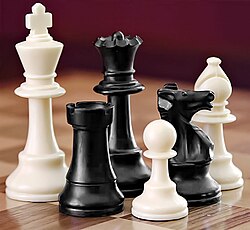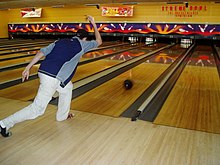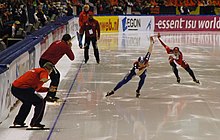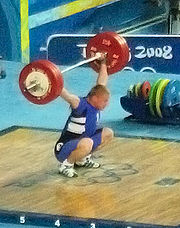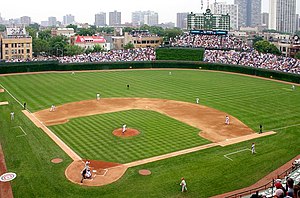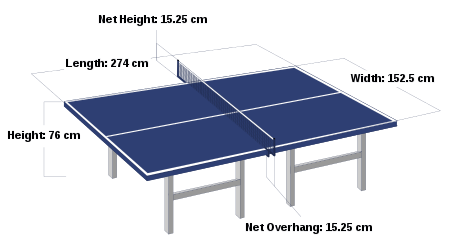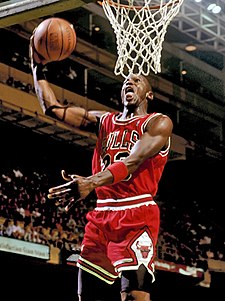1940s–1960s
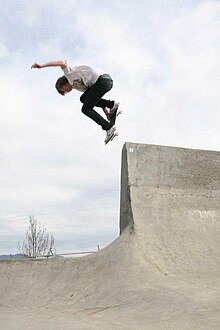
Skateboarder in Grants Pass, Oregon
Skateboarding was probably born sometime in the late 1940s or early 1950s when surfers in California
wanted something to surf when the waves were flat. No one knows who
made the first board; it seems that several people came up with similar
ideas at around the same time. These first skateboarders started with
wooden boxes or boards with roller skate wheels attached to the bottom.
The boxes turned into planks, and eventually companies were producing
decks of pressed layers of wood – similar to the skateboard decks of
today. During this time, skateboarding was seen as something to do for
fun besides surfing, and was therefore often referred to as "Sidewalk
Surfing".
The first manufactured skateboards were ordered by a Los Angeles, California
surf shop, meant to be used by surfers in their downtime. The shop
owner, Bill Richard, made a deal with the Chicago Roller Skate Company
to produce sets of skate wheels, which they attached to square wooden
boards. Accordingly, skateboarding was originally denoted "sidewalk
surfing" and early skaters emulated surfing style and maneuvers. Crate scooters
preceded skateboards, and were borne of a similar concept, with the
exception of having a wooden crate attached to the nose (front of the
board), which formed rudimentary handlebars.
A number of surfing manufacturers such as Makaha
started building skateboards that resembled small surfboards, and
assembling teams to promote their products. The popularity of
skateboarding at this time spawned a national magazine, Skateboarder Magazine,
and the 1965 international championships were broadcast on national
television. The growth of the sport during this period can also be seen
in sales figures for Makaha, which quoted $10 million worth of board
sales between 1963 and 1965 (Weyland, 2002:28). Yet by 1966 the sales
had dropped significantly (ibid) and Skateboarder Magazine had stopped
publication. The popularity of skateboarding dropped and remained low
until the early 1970s.
1970s

A skateboarder in Tallahassee, Florida
In
the early 1970s, Frank Nasworthy started to develop a skateboard wheel
made of polyurethane, calling his company Cadillac Wheels.
Prior to this new material, skateboards wheels were metal or "clay"
wheels. The improvement in traction and performance was so immense that
from the wheel's release in 1972 the popularity of skateboarding started
to rise rapidly again, causing companies to invest more in product
development. Nasworthy commissioned artist Jim Evans
to do a series of paintings promoting Cadillac Wheels, they were
featured as ads and posters in the resurrected Skateborder magazine, and
proved immensely popular in promoting the new style of skateboarding.
Many companies started to manufacture trucks (axles) specially designed
for skateboarding, reached in 1976 by Tracker Trucks.
As the equipment became more maneuverable, the decks started to get
wider, reaching widths of 10 inches (250 mm) and over, thus giving the
skateboarder even more control. Banana board is a term used to describe skateboards made of polypropylene
that were skinny, flexible, with ribs on the underside for structural
support and very popular during the mid-1970s. They were available in
myriad colors, bright yellow probably being the most memorable, hence
the name.
Manufacturers started to experiment with more exotic composites and metals, like fiberglass and aluminium,
but the common skateboards were made of maple plywood. The
skateboarders took advantage of the improved handling of their
skateboards and started inventing new tricks. Skateboarders, most
notably Ty Page, Bruce Logan, Bobby Piercy, Kevin Reed, and the Z-Boys
(so-called because of their local Zephyr surf shop) started to skate
the vertical walls of swimming pools that were left empty in the 1976 California drought.
This started the vert trend in skateboarding. With increased control,
vert skaters could skate faster and perform more dangerous tricks, such
as slash grinds and frontside/backside airs. This caused liability
concerns and increased insurance costs to skatepark owners, and the
development (first by Norcon,
then more successfully by Rector) of improved knee pads that had a hard
sliding cap and strong strapping proved to be too-little-too-late.
During this era, the "freestyle" movement in skateboarding began to
splinter off and develop into a much more specialized discipline,
characterized by the development of a wide assortment of flat-ground
tricks.
As a result of the "vert" skating movement, skate parks had to
contend with high-liability costs that led to many park closures. In
response, vert skaters started making their own ramps, while freestyle
skaters continued to evolve their flatland style. Thus by the beginning
of the 1980s, skateboarding had once again declined in popularity.
1980s

Skateboarder at Skateistan in Kabul, Afghanistan
This
period was fueled by skateboard companies that were run by
skateboarders. The focus was initially on vert ramp skateboarding. The
invention of the no-hands aerial (later known as the ollie) by Alan
Gelfand in Florida in 1976, and the almost parallel development of the grabbed aerial by George Orton and Tony Alva
in California, made it possible for skaters to perform airs on vertical
ramps. While this wave of skateboarding was sparked by commercialized
vert ramp skating, a majority of people who skateboarded during this
period didn't ride vert ramps. As most people could not afford to build
vert ramps, or did not have access to nearby ramps, street skating increased in popularity.
Freestyle skating remained healthy throughout this period, with pioneers such as Rodney Mullen
inventing many of the basic tricks that would become the foundation of
modern street skating, such as the "Impossible" and the "kickflip".
The influence that freestyle exerted upon street skating became
apparent during the mid-1980s; however, street skating was still
performed on wide vert boards with short noses, slide rails, and large
soft wheels. In response to the tensions created by this confluence of
skateboarding "genres", an rapid evolution occurred in the late 1980s to
accommodate the street skater. Since few skateparks were available to
skaters at this time, street skating pushed skaters to seek out shopping
centers and public and private property as their "spot" to skate
(public opposition, in which businesses, governments, and property
owners have banned skateboarding on properties under their jurisdiction
or ownership, would progressively intensify over the following decades).
By 1992, only a small fraction of skateboarders remained as a highly
technical version of street skating, combined with the decline of vert
skating, produced a sport that lacked the mainstream appeal to attract
new skaters.
1990s–present
The current generation of skateboards is dominated by street skateboarding. Most boards are about 71⁄4
to 8 inches (180 to 200 mm) wide and 30 to 32 inches (760 to 810 mm)
long. The wheels are made of an extremely hard polyurethane, with
hardness (durometer)
approximately 99A. The wheel sizes are relatively small so that the
boards are lighter, and the wheel's inertia is overcome quicker, thus
making tricks more manageable. Board styles have changed dramatically
since the 1970s but have remained mostly alike since the mid 1990s. The
contemporary shape of the skateboard is derived from the freestyle
boards of the 1980s with a largely symmetrical shape and relatively
narrow width. This form had become standard by the mid '90s. Go Skateboarding Day
was created in 2004 by a group of skateboarding companies to promote
skateboarding and help make it more noticeable to the world. It is
celebrated every year on June 21.






